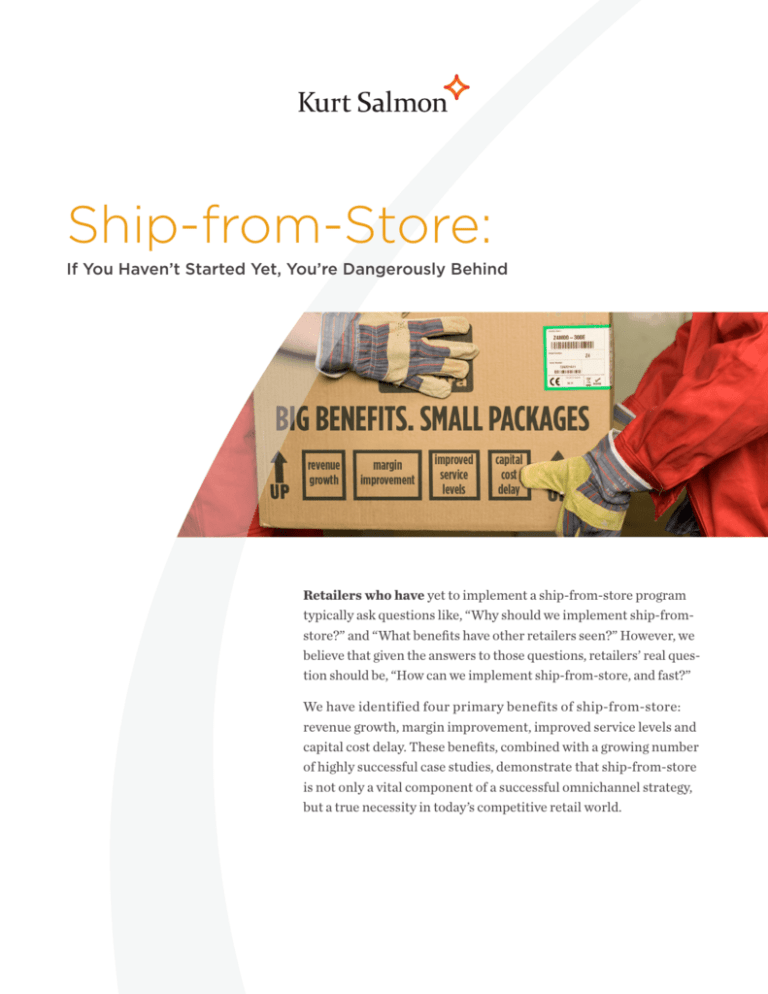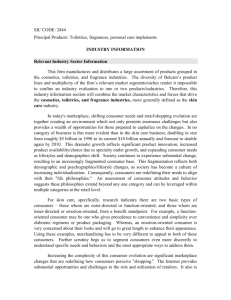Ship-from-Store: Benefits & Implementation for Retailers
advertisement

Ship-from-Store: If You Haven’t Started Yet, You’re Dangerously Behind Retailers who have yet to implement a ship-from-store program typically ask questions like, “Why should we implement ship-fromstore?” and “What benefits have other retailers seen?” However, we believe that given the answers to those questions, retailers’ real question should be, “How can we implement ship-from-store, and fast?” We have identified four primary benefits of ship-from-store: revenue growth, margin improvement, improved service levels and capital cost delay. These benefits, combined with a growing number of highly successful case studies, demonstrate that ship-from-store is not only a vital component of a successful omnichannel strategy, but a true necessity in today’s competitive retail world. Top-line growth is the biggest benefit enjoyed by many retailers executing ship-from-store, driven by capturing sales that may have been lost without it. Revenue Growth Top-line growth is the biggest benefit enjoyed by many retailers executing ship-from-store, driven by capturing sales that may have been lost without it. Using store inventory to fulfill Web orders of products that are out of stock at distribution centers results in immediate revenue boosts of up to 10% to 20% by making more inventory available for sale. For example, online sales at American Apparel have increased by 30% since they started using their stores as backup fulfillment centers. And Nordstrom attributes a 39% online sales bump to efforts to integrate its online and in-store inventories. Finally, Urban Outfitters CEO Richard Hayne estimates that half of the retailer’s direct-to-consumer demand would have been lost due to out-of-stock situations in DCs. Ship-from-store also drives revenue growth by satisfying demand for products that are out of stock in a specific store. Employees at ship-from-store– enabled retailers can look across their inventory in other stores and ship products directly to customers who might have looked elsewhere in the past. Men’s Wearhouse estimates that they save over 1,000 orders per day by leveraging inventory from other stores to fulfill demand when a local store is out of stock. Assuming a conservative average ticket of $50, this adds $18 million of top-line revenue. Finally, ship-from-store is an increasingly important piece of the puzzle for retailers who carry more items online than in-store, striving to achieve an endless aisle assortment. In the past, online-only items returned to stores were either placed on clearance racks or returned to distribution centers. But with ship-from-store, retailers are able to sell these returned items at full price by using them to fulfill online orders. 2 | WHY SHIP-FROM-STORE Margin Improvement Retailers who implement ship-from-store can also look forward to overall margin improvements driven by higher full-price sell-through and decreased COGS. When in-store products are available to be sold online, the probability of a full-price sale before (or during) the markdown cycle goes up significantly. Retailers such as Ann Taylor and Danier Leather have seen their margins increase 1% to 2% overall and up to 30% on items nearing markdown. In fact, Ann Taylor’s CEO notes that by using ship-fromstore, “We are able to liquidate product on markdown at a much higher gross margin rate.” On the other side of the profit equation, using stores as distribution points lowers parcel shipment costs and therefore drives COGS decreases (as seen by Toys R Us and Jos. A. Bank). For example, as a result of its ship-from-store program, Toys R Us was able to deliver 94% of its store shipments via ground in two days as single-zone parcels, reducing freight costs and improving order cycle times. The cost savings from skipping a shipping zone can more than make up for the decreased shipping economies of scale found at stores. Plus, ship-from-store leads to increased inventory turns and decreased safety stock at distribution centers. As a result of its ship-from-store program, Nordstrom’s turnover spiked to 5.41 from a previous five-year high of 4.84. And one major department store saw improvements on both sides, with a 20% increase in same-store sales growth that led to a $200 million improvement in gross margin along with a $200 million reduction in average inventory, which drove down costs. Many larger retailers and department stores with growing e-commerce sales are using ship-from-store to defer investing capital in additional distribution centers. Improved Service Levels One of the most publicized reasons to pursue shipfrom-store is the change in consumer service level expectations brought about by pure-play e-commerce companies. While not every retailer needs to offer next-day shipping, the drive to compete around service time and shipping costs is very real for most. Best-in-class retailers are now fulfilling orders from stores in less than an hour to compete with e-commerce giants like Amazon. Walmart recently announced it will begin using 50 stores as fulfillment locations to combat Amazon with better speed to customers and is even considering using its customer base for same-day deliveries. Capital Cost Delay Many larger retailers and department stores with growing e-commerce sales are using ship-fromstore to defer investing capital in additional distribution centers. With increasing e-commerce business beginning to stress fulfillment capacities to the breaking point during peak season, retailers without ship-from-store capabilities are often operating at maximum capacity. This means that if they want to increase their delivery speeds, their only option is to invest ~$100 million for a new distribution center to cover peak periods (during which demand can spike five to 10 times higher than average). This is an expensive proposition that can add up quickly for businesses growing e-commerce sales by double digits year over year. In many cases, the cheaper option is to enable ship-from-store in enough stores to reduce the strain. Macy’s chief of stores Peter Sachse summed it up best in a recent Wall Street Journal interview: “We’ve spent the last 153 years building warehouses. We just called them stores.” CASE STUDY: Ship-from-Store’s Many Benefits Issue: Toys R Us wanted to continue to remain competitive by reducing costs and improving in-stock rate and delivery speeds. Solution: In just 90 days, Toys R Us implemented ship-from-store in 10 pilot stores and rolled the program out to an additional 80 doors three weeks later. A year later, they had enabled an additional 750 stores. Each store fulfills an average of 300 orders a day during peak season, which equates to about 50,000 daily orders across the store network. Result: Toys R Us successfully fulfilled 1.3 million ship-from-store orders in the months of November and December, which represented 15% of their peak e-commerce fulfillment. Of those orders, 33% were for inactive or older products not moving at stores, reducing the need to mark down those items. And 94% of those orders shipped within two days during peak season, improving the customer experience and ensuring that Toys R Us remained competitive against online-only competitors. Getting Started In light of these compelling benefits, it’s no surprise that many retailers are racing to implement shipfrom-store programs. But in a rush to enable shipfrom-store, retailers can put their profitability and customer experience at risk. A carefully planned approach will help minimize risk, and it starts with strategic decisions like defining store coverage, creating order management rules and detailing key organizational changes. With those answers in place, retailers can shift to tactical decisions WHY SHIP-FROM-STORE | 3 around optimal store operations. While the typical implementation for a large, 500+ store chain usually takes less than two months and can begin to deliver results immediately, the ability to execute against these strategic and tactical issues will separate winners from losers over the next five years. We recently explored these strategic and tactical considerations in “Winning the Ship-from-Store Battle: Strategies and Tactics.” v Kurt Salmon is currently conducting an e-commerce delivery study to develop benchmarks for delivery speed, shipping costs and service levels across a variety of retail segments. Retailers interested in participating should contact Steve Osburn at steve.osburn@kurtsalmon.com. AUTHORS Frank Layo and Nathan Silver advise the world’s leading retailers on their supply chain and omnichannel fulfillment strategies and operations. They can be reached at frank.layo@kurtsalmon.com and nathan.silver@kurtsalmon.com. Kurt Salmon is the leading global management consulting firm specializing in the retail and consumer products industry. We leverage our unparalleled industry expertise to help business leaders make strategic, operational and technology decisions that achieve tangible and meaningful results. For more information, go to www.kurtsalmon.com. © 2013







![[DATE] Mary Ziegler Director Division of Regulations, Legislation](http://s3.studylib.net/store/data/007212021_1-b96b03cd98cadfc74a22865c0247494d-300x300.png)